United States historic place
| The Jay Estate | |
| U.S. Historic district Contributing property | |
| U.S. National Historic Landmark District Contributing Property | |
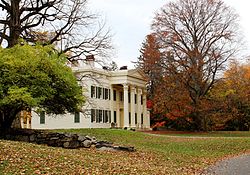 The Jay Estate in Rye, NY The Jay Estate in Rye, NY | |
| Location | 210 Boston Post Road, Rye, New York |
|---|---|
| Coordinates | 40°57′26″N 73°42′22″W / 40.957304°N 73.706084°W / 40.957304; -73.706084 |
| Area | 23 acres with 3 owners: NY State Parks, Westchester County Parks and the Jay Heritage Center |
| Built | 1745 (1745); 1838; 1907 |
| Built by | Edwin Bishop with influences by Minard Lafever, Asher Benjamin and Chester Hills; Frank A. Rooke |
| Architectural style | Greek Revival; Classical Revival |
| Restored by | Jay Heritage Center |
| Website | www.jayheritagecenter.org |
| Part of | Boston Post Road Historic District (Rye, New York) (ID82001275) |
| Significant dates | |
| Added to NRHP | October 29, 1982 |
| Designated NHLDCP | August 30, 1993 |
The Jay Estate is a 23-acre park and historic site in Rye, New York, with the 1838 Peter Augustus Jay House at its center. It is the keystone of the Boston Post Road Historic District, a National Historic Landmark District (NHL) created in 1993. The site is the surviving remnant of the 400-acre (1.6 km) farm where US Founding Father, John Jay (December 12, 1745 – May 17, 1829), grew up. It is also the place where Jay returned to celebrate the end of the American Revolutionary War, after he negotiated the 1783 Treaty of Paris with fellow peacemakers John Adams and Benjamin Franklin. The preserved property is located on the south side of the Boston Post Road (US 1) and has a 3⁄4-mile (1.2 km) view of Milton Harbor.
The Jay Estate is a recognized historical resource. It is part of a 10,000+ year old Indigenous peoples archaeological site and overlooks the oldest man-managed meadow on record in New York State. It is a significant African American Heritage Trail site. The Jay Estate is also one of a select few national landmarks devoted to education about the seven Founding Fathers including Washington's Mount Vernon, Jefferson's Monticello, Hamilton's The Grange, Madison's Montpelier and Jay's retirement home the John Jay Homestead.
Ownership and stewardship
The Jay Estate has 3 discrete owners:New York State Parks, Westchester County and the Jay Heritage Center. New York State Parks (90%) and Westchester County (10%) own a 21.5 acre parcel known as the "Jay Property" as tenants in common while the non-profit Jay Heritage Center (JHC) owns 1.5 acres outright including the Jay Mansion and the 1907 Van Norden Carriage House. A 2013 public-private partnership and agreement awarded stewardship of the State and County's 21.5 acres, including preservation, restoration and interpretation to the Jay Heritage Center (JHC). Under the operating agreement, JHC receives no funds from New York State, Westchester County or the City of Rye. All monies for improvements are raised through individual donations, corporate gifts and grants. Because of the significance of the site, all preservation work is done with adherence to the standards of the Department of the Interior.
The Jay Estate is located adjacent to the Marshlands Conservancy, a completely separate nature preserve owned and operated 100% by Westchester County Parks.
History
Indigenous peoples settlement site
As a component of the Boston Post Road Historic District, the Jay Estate has been further recognized as an archaeologically significant area. There are known affiliations with Middle Woodland, Late Woodland, Late Archaic and periods of historic significance of 3000-4999 BC, 1000-2999 BC, 1499-1000 AD, 1749-1500 AD, 1825-1849, and 1850-1874.
Childhood Home of John Jay
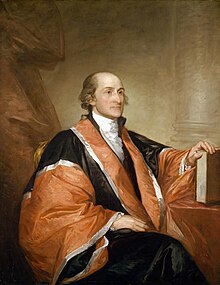
Of America's seven most notable Founding Fathers - George Washington, John Adams, Jay, Benjamin Franklin, Alexander Hamilton, Thomas Jefferson and James Madison - Jay alone was born in what would become the settler-colonial territory of New York State. He was raised in Rye from 3 months at what he called the "Family Seat" a 400-acre (160 ha) farm later named "The Locusts" overlooking Long Island Sound. The property had been first leased then purchased by his father Peter from Rye settler John Budd before Jay's birth.
Jay was home schooled by his mother Mary until 8 years old. He had three siblings with disabilities who lived there as well - Augustus who suffered from learning disabilities and Anna and Peter who were both blind. Two other siblings, an older sister Eve and a younger brother Frederick also occupied the house. The estate at this time was also home to 8 enslaved people according to a 1755 New York State Census; remnants of what appears to have been an enslaved person's dwelling were discovered in August 2017. Based on archival drawings, the core property at that time had several smaller outbuildings including an ice house, stable, smokehouse and additional dwellings clustered around the main house including a still extant farmhouse that dates to the mid 1760s. Numerous wells provided water on the property along with two other freshwater sources known as the East Stream and West Creek. Crops included potatoes.
At 14 years old, Jay went to New York City to study law at Kings College (today's Columbia University) but continued to come home fortnightly to spend time and holidays with family. Exchanges with his father reveal the names of enslaved persons living at the site include Moll, Old Plato, Little Plat, Old Mary, Young Mary, Zilpha, Clarinda and Anthony.
Family Seat
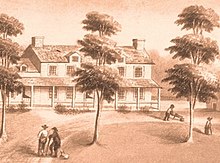
When the Stamp Act compelled Jay and many other lawyers to strike in defiance of British law, he returned there to live from 1765 to 1766, and immersed himself in re-reading the classics. After negotiating the Treaty of Paris that ended the Revolutionary War, Jay rejoiced with family and friends at his home in Rye in July, 1784. While Governor of New York, Jay notes "I am the owner of one undivided half part of a lot of land containing by estimation seventy acres, in the township of Rye adjacent to the farm of Peter Jay and occupied by him." – John Jay, October 1, 1798. John Jay and members of his family spent time there including his wife Sarah Livingston Jay and his youngest son William. After Jay's retirement to Bedford, he inherited his brother's portion of the estate and oversaw management of the property from 1813 to 1822 before transferring it to his eldest son Peter Augustus in 1822. Still he advised on the planting of numerous trees.
During this period, the landscape began to change. Dry-laid stone ha-ha walls replaced fences and the view to the Long Island Sound was more formally shaped. Three large elm trees were planted behind the main house to replace three locusts that had fallen during the September Gale of 1822. The last enslaved resident of the property, a man named Caesar Valentine, was freed in 1824 and remained at the Jay Estate in the employ of the Jay family until his death and burial on the farm in 1847.
Famous visitors to the Jay Estate during this period include Yale President Timothy Dwight IV, American novelist James Fenimore Cooper, artist and inventor Samuel F. B. Morse.
The 1838 Jay Mansion (also known as the Peter Augustus Jay House)
Seven years after his father's death, Peter reluctantly took down the ancestral house but reincorporated its timbers, doors, shutters and nails into a new 1838 structure, locating the second construction on the footprint of the first building. Stylistic elements appear to have been influenced by architectural pattern books by Minard Lafever, Asher Benjamin and Chester Hills. While the style of the mansion's facade is grand, the rear piazza replicates the simplicity and same dimensions of the first house, one story high and 80 feet (24 m) long.

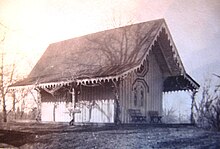
Alansten
After Peter Augustus Jay's death in 1843, the Jay Estate passed down to his son John Clarkson Jay a noted conchologist, member of the Lyceum of Natural History doctor and co-founder of New York Yacht Club. Dr. Jay made changes to the mansion which included rerouting the central hall staircase. In 1849, he added a Carpenter Gothic cottage based upon designs by Alexander Jackson Davis as well as a bowling alley. He also gave the property the new name of "Alansten." Portions of the property were leased by gardeners and farmers who managed the surrounding land for the Jay family as a dairy farm. The property was kept open for livestock and planted with crops of rye, wheat and corn.
The home and surrounding acreage stayed in the Jay family through 1904. Other notable owners and residents of the property during this period include landscape architect Mary Rutherfurd Jay, her brother Pierre Jay, first Chairman of the Federal Reserve Bank of New York, and art collector and philanthropist Junius Spencer Morgan II.
20th Century Owners
Owners of the Jay Estate in modern times included architect Henry Ives Cobb (1904) who purchased the land with hopes to develop it; Dutch financier Warner M. Van Norden and Grace Talcott (1905-1911) who kept rare animals including Highland cattle and Grevy zebras; Princeton benefactor and Palmer Square creator Edgar Palmer and his wife Zilph (1911-1935); National Horse Show President Walter B. Devereux and his wife Zilph (1935-1966); the Methodist Church (1966-1979); and lastly DGM Partners, a real estate concern (1979-1992).
It is during this period (circa 1917) that a large Indoor Tennis House is constructed. Landscape architects Brinley & Holbrook redesign the gardens.
Threat of Development (1979 - 1992)
The Jay Estate was threatened by development in 1979. The conflict that arose galvanized the advocacy efforts of more than 62 historical and environmental organizations known as the "Jay Coalition" (the precursor to today's Jay Heritage Center) together with numerous government officials. Supreme Court Justice Harry A. Blackmun was a visitor to the site during this time.
During this chapter of change, and upon seeing the preserved landscape and viewshed of John Jay's youth and early adulthood, Justice Harry Blackmun remarked,
It was a place that struck me then as symbolic of what was impressive about certain aspects of the latter part of the 18th century—gracious living and status to be sure, but coupled with a sense of responsibility, particularly to government and to the art of getting along together.
— Harry Blackmun, Associate Justice, United States Supreme Court
It is also during this window that the surrounding Boston Post Road Historic District was added to the National Historic Register of Places (1982).
In 1992, after 13 years of negotiations and public hearings, Westchester County purchased the 23 acre property for $11.5 million and the Jay Estate was preserved. Two buildings and 1.5 acres in the center of that parcel were sold to the Jay Heritage Center.
Preservation and Interpretation (1993 - Today)

In 1993, the Jay Estate and surrounding properties were further elevated in stature and included in a National Historic Landmark District by the National Park Service. In keeping with this distinction, preservation of the Jay Estate adheres to standards set by the Department of the Interior. In 1997, New York State Parks purchased a 90% interest in the remaining 21.5 acres to become tenants in common with Westchester County.
Despite best efforts to maintain the property, the landscape fell into disrepair. By 2011, the integrity of the property was again in jeopardy. Charles A. Birnbaum of The Cultural Landscape Foundation declared the Jay Estate an at-risk landscape. To help build consensus for ways to move constructively forward, Birnbaum and Jay Heritage Center co-sponsored a day-long symposium called "Bridging the Nature Culture Divide." Landscape design professionals and members of the community were invited to reimagine how components of the landmark like its historic gardens and meadow could be reimagined in a sustainable manner. The event was so successful that it was repeated at other national sites. Subsequent forums were co-sponsored by the Central Park Conservancy (2012) and the Presidio Trust (2015).
In 2013, the non-profit Jay Heritage Center was awarded stewardship of the park under a private-public partnership agreement following legislative approval by Westchester County in 2012.

Today the 3 owners of the park - NY State Parks, Westchester County and the Jay Heritage Center (JHC) collaborate to ensure the national treasure can be enjoyed by future generations. The partnership has been so successful that JHC was honored with a NY State Historic Preservation Award for Non-Profit Achievement in December 2022 by Governor Kathy Hochul and NY State Parks Commissioner Erik Kullesid.
Components
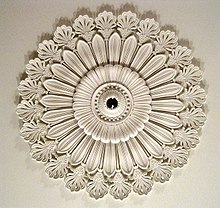
- 1838 Jay Mansion
(Owned by JHC)
Pieces of the original 18th century house "The Locusts" found within the mansion are also on public view and illustrate sustainable building traditions. JHC uses the house to host programs in American history, architecture, landscape conservation and environmental stewardship. Architects involved in the restoration process include Beyer Blinder Belle. One of the most significant additions included installation of a geothermal heating and cooling system. The building is an official Save America's Treasures project and was one of 63 recipients of the prestigious federal grant in 2001.
- 1907 Van Norden Carriage House
(Owned by JHC)
The Carriage House was designed by architect Frank A. Rooke. Today, it is used for lectures, programs and concerts. It boasts its original working 1907 Seth Thomas tower clock. Architects involved in the restoration process include Beyer Blinder Belle.
- Meadow
(Owned by JHC, NYSOPRHP and Westchester County; maintained and operated by JHC)
Larry Weaner Landscape Architects were selected to rehabilitate a two-acre area full of invasive species and replant the space with native grasses and wildflowers. The goal is to attract more meadow and grassland birds which are in decline.
- Historic Jay Gardens


(Owned by NYSOPRHP and Westchester County; maintained and operated by JHC)
The original estate gardens had wooden pales that were later replaced by stone fences. Sections of the dry laid stone walls that frame the spaces date from the late 1700s, 1822 and later. The gardens evolved and were even opened on occasion to the public in the 20th century.
Today they are open to the public again. The firm of Nelson Byrd Woltz Landscape Architects was selected to draw plans to restore and rehabilitate the gardens. Work is being funded through more than $500,000 in donations raised by the Jay Heritage Center and a matching grant $500,000 REDC grant from New York State Parks
- 1917 Tennis House
(Owned by NYSOPRHP and Westchester County; maintained and operated by JHC)
The "covered" Tennis House is believed to be one of the oldest indoor courts in the country. It is being restored for eventual use by youth groups. The structure was neglected for many years and further damaged during Hurricane Sandy. It is currently undergoing stabilization.
- 1907 Zebra House
(Owned by NYSOPRHP and Westchester County; maintained and operated by JHC)
Historic designations
African American Heritage Trail (2004)
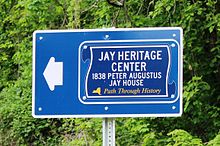
The site is known to have been the home and burial site of numerous men and women owned and freed by the Jay family. As such, the estate was designated one of 16 sites on the African American Heritage Trail of Westchester County in 2004. John Jay is well known for a contradictory legacy of owning enslaved individuals while simultaneously advocating emancipation, serving as the first President of the New-York Manumission Society, and establishing the first African Free School. His son Peter Augustus Jay also served as President of the Manumission Society, continuing his work.
Hudson River Valley National Heritage Area (2009)
In November 2008, the PAJ House became the oldest National Historic Landmark structure in New York State to be equipped with an energy-efficient geothermal heating and cooling system. One year later, the 23-acre Jay Estate was designated a member site of the Hudson River Valley National Heritage Area (HRVNHA) in January 2009, based on its architectural and historic significance as well as green management practices and design efforts in sustainability. The HRVNHA is a prestigious designation by the National Park Service (NPS).
The Jay mansion has been recognized as an outstandingly pure example of Greek Revival architecture.
The Peter Jay House ... is undeniably a major architectural landmark. This monumental Greek Revival style house has been generally recognized as one of the most important buildings of its type in the country. Its symmetrical massing, bold scale, and grandly austere detail are an extraordinary symbol of the increasing wealth and power of America during the decade of the 1830s. The house also reflects the importance of the Jay family in a maturing nation.
— Andrew Dolkart, architectural historian
NY Path Through History (2013)
In 2013, the Jay Estate was added to New York State's Path Through History as an important site that explores themes and the evolution of Civil Rights.
Flora and fauna
Native plants and trees found at the Jay Estate include elms, oaks and red maples. The park is also home to numerous wild turkeys, red tailed hawks and coyotes.
Numerous invasive species at the Jay Estate have been noted and mapped with GPS coordinates using the iNaturalist app. Species found including mugwort, multiflora rose, Norway maples, Japanese angelica tree, jetbead, Japanese stiltgrass, Japanese knotweed and wineberry.
Popular culture
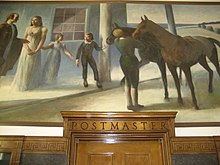
- James Fenimore Cooper, a family friend and frequent visitor to both Jay family homes in Rye and Bedford, gave the Rye estate its name, The Locusts. The setting featured prominently in Cooper's first successful novel The Spy (1821). It is believed that the character of Caesar Thompson in the book was based on Caesar Valentine who was enslaved and later freed by the Jay family.
- John Jay at His Home is the title of a Guy Pene du Bois painting at the Rye Post Office that shows John Jay about to leave his Rye home and family to ride circuit.
- The Jay Estate was featured in a popular 2017 NFL and Bud Light ad titled "The Hero's Return."
A History Channel documentary on Alexander Hamilton used the site to recreate scenes of Hamilton's youth, marriage and duel with Aaron Burr.
- In the 1980s, a cult horror film, Spookies, was filmed at the property.
- The Mansion interiors and Jay meadow have appeared in numerous photo shoots for print fashion publications like W Magazine. In 2019, Tory Burch shot her Fall/Winter campaign at the Jay Estate.
- Several episodes of Season 3 of Apple TV's show Dickinson about the poet Emily Dickinson featuring Hailee Steinfeld and directed by Silas Howard were filmed at the property in 2021 using both meadow and the mansion.
See also
References
- ^ "National Register Information System". National Register of Historic Places. National Park Service. January 23, 2007.
- ^ "Boston Post Road Historic District". National Historic Landmark summary listing. National Park Service. September 14, 2007. Archived from the original on December 14, 2007.
- ^ Clement, Douglas P. (March 13, 2016). "At the Jay Heritage Center in Rye: Young Americans". The New York Times.
- Kennedy, Karen; O'Brien, Austin (December 12, 1986). "National Register of Historic Places Inventory-Nomination: Boston Post Road Historic District" (pdf). National Register of Historic Places Inventory. National Park Service. and Accompanying 33 photos, exteriors and interiors, from 1979-1983. (7.94 MB)
- Herbert Alan Johnson, John Jay 1745-1829 (The University of the State of New York, The State Education Department, 3d edition, Revised in 1995 to Commemorate the 250th Anniversary of the Birth of John Jay, Born December 12, 1745, p.57.)
- Clary, Suzanne (November 2017). "What Becomes a Landmark Most". Rye Magazine. No. 61. Weston Magazine Publishers. Retrieved February 19, 2018.
- Richard B. Morris, Seven Who Shaped Our Destiny: The Founding Fathers as Revolutionaries (New York: Harper & Row, 1973)
- "Westchester Building, Rye, N.Y.". New York Evening Post. May 13, 1922.
- Hubbard, Elbert, "John Jay," Magazine of American History, New York, January, February, March Issue 1902, p.27.
- RYE CITY LOCAL WATERFRONT REVITALIZATION TASK FORCE, Marcia Kapilow, Chairman, FREDERICK E. ZEPF, CITY PLANNER. "CITY OF RYE LOCAL WATERFRONT REVITALIZATION PROGRAM" (PDF). Retrieved November 29, 2019.
{{cite web}}: CS1 maint: multiple names: authors list (link) - "CULTURAL RESOURCES INVENTORY LONG ISLAND SOUND - DREDGED MATERIAL MANAGEMENT PLAN, Long Island Sound, Connecticut, New York, and Rhode Island, VOLUME I, Contract #W921WJ-08-R-002, WHG #PAL0002" (PDF). PAL Publications. August 2010. p. 104. Retrieved May 18, 2020.
- Pfeiffer, John, "Preliminary Archaeological Survey of the Boston Post Road Historic District of Rye, NY," April 21, 1982. p. 2
- ^ "African American Heritage Trail brochure". Westchester County, New York. Retrieved December 17, 2021.
- "Jay Heritage Center". New York State Parks. Retrieved April 30, 2020.
- ^ Westchester County Board of Legislators (November 26, 2012). "ACT 2012-173 Jay Property Estate Restoration/Maintenance". Retrieved February 20, 2018.
- "CULTURAL RESOURCES INVENTORY LONG ISLAND SOUND - DREDGED MATERIAL MANAGEMENT PLAN, Long Island Sound, Connecticut, New York, and Rhode Island, VOLUME I, Contract #W921WJ-08-R-002, WHG #PAL0002" (PDF). PAL Publications. August 2010. pp. 103–105. Retrieved May 18, 2020.
- "Boston Post Road Historic District". National Register of Historic Places. Retrieved May 21, 2020.
- Clary, Suzanne (October 2014). "From a Peppercorn to a Path Through History". Upper East Side Magazine. No. 53. Weston Magazine Publishers.
- Hoover, Ken (November 5, 2003). "John Jay, America's Diplomat; God Is In The Details: First secretary of state, chief justice heeded the fine print". Investor's Business Daily.
- Wilcox, Arthur Russell (1918). The Bar of Rye Township, Westchester County, New York. Knickerbocker Press. p. 36 – via Internet Archive.
john Jay rye church wardens groce.
- Kennedy & O'Brien 1986, p. 13.
- "Zebra Testing Scheme". Amsterdam Evening Recorder. November 15, 1906. p. 3, paragraph 3.
- "SOUND, Shrewd property-owners developed area landscape". Gannett Newspapers. April 20, 1981. p. A9.
- Hershenson, Roberta (April 28, 1996). "After Years of Conflict, Jay Sites Are Opening to the Public". The New York Times.
- Justice Harry A. Blackmun, "John Jay and the Federalist Papers," Pace Law Review, 1988
- "The Jay Estate". TCLF. Retrieved February 20, 2023.
- Lisa Petri (January 23, 2015). "Presidio Trust to Host Cultural Landscape Foundation Conference: Bridging the Nature-Culture Divide III: Saving Nature in a Humanized World". The Presidio Trust. Retrieved February 20, 2023.
- "Act 2012-173, Jay Property Estate Restoration/Maintenance". Westchester County Board of Legislators. November 26, 2012. Retrieved March 26, 2022.
- "Governor Hochul Announces New York State Historic Preservation Awards for 2022". New York State. December 28, 2022. Retrieved February 20, 2023.
- Berger, Joseph (March 2, 2008). "What's a Historic House You Can't Enter in Style?". The New York Times.
- "Congressional Record - House" (PDF). US Congress. October 11, 2001. Retrieved January 19, 2020.
- Suzanne Clary (April 8, 2016). "The Horse Show Bride and Groom". SoHoNYC. Weston Magazine Group. Retrieved September 4, 2019.
- "Palmer Gardens in Rye to Be Opened Next Saturday". The Yonkers Statesman and News. Yonkers, New York. June 24, 1924. p. 10.
- "Jay Heritage Center". Nelson Byrd Woltz Landscape Architects. Retrieved May 21, 2020.
- Suzanne Clary (August 14, 2015). "More Good News for the Historic Jay Estate". The Cultural Landscape Foundation. Retrieved October 15, 2019.
- Bill Cary (February 27, 2015). "Jay Gardens in Rye to get $1.5 million makeover". The Journal News. Retrieved October 15, 2019.
- Caitlin Brown (June 2, 2017). "The Jewel in Our Backyard". The Rye Record. Retrieved October 15, 2019.
- "Governor Cuomo Announces $6.2 Million in Grants For Historic Properties Damaged By Superstorm Sandy". Governor Andrew M. Cuomo. August 4, 2015. Archived from the original on August 20, 2020. Retrieved May 18, 2020.
- Congresswoman Nita Lowey (August 8, 2008). "Jay Heritage Center to Become Energy Efficient". Retrieved March 18, 2018.
- ^ Rye Sustainability Committee. "City of Rye Sustainability Plan". City of Rye. Retrieved May 24, 2020.
- Hudson River Valley National Heritage Area. "Jay Heritage Center".
- New York State Path Through History. "Jay Heritage Center". Archived from the original on February 21, 2018. Retrieved March 18, 2018.
- Arthur Stampleman (December 5, 2014). "Public Art". The Rye Record. Retrieved October 15, 2019.
- "The Hero's Return". YouTube. Retrieved February 21, 2018.
- "Hamilton: Building America -Alexander Hamilton vs. Aaron Burr | History". YouTube. July 7, 2017. Archived from the original on December 21, 2021. Retrieved May 24, 2019.
- Max Evry (October 15, 2014). "The Strange Saga of Spookies". The Dissolve. Archived from the original on January 26, 2022. Retrieved April 28, 2018.
- "Fall/Winter 2019". Tory Burch. Archived from the original on December 21, 2021. Retrieved October 15, 2019.
- Mary Elizabeth Andriotis (November 8, 2021). "How Two Historic House Museums Were Transformed for Season Three of Dickinson". House Beautiful. Retrieved November 11, 2021.
Sources
- Jay, John. Memorials of Peter A. Jay 1905. G.J. Thieme.
- Wells, Laura Jay The Jay Family of La Rochelle and New York, 1938. Order of Colonial Lords of Manors in America.
- Morris, Richard B. Seven Who Shaped Our Destiny: The Founding Fathers as Revolutionaries (New York: Harper & Row, 1973).
- Pfeiffer, John "Preliminary Archaeological Survey of the Boston Post Road Historic District of Rye, NY," April 21, 1982.
- The Modern Builder's Guide, 1833.
- The Beauties of Modern Architecture, 1835.
- Johnson, Herbert Alan, John Jay 1745-1829, 3d Edition, 1995. The University of the State of New York, The State Education Department.
External links
- Jay Heritage Center - Official site
- New York State Historic Sites: Jay Heritage Center
- Library of Congress - Local Legacies - Jay Heritage Center
- The Papers of John Jay, an image database and indexing tool comprising 13,000 documents from the Rare Book & Manuscript Library at Columbia University and approximately 90 other institutions
| Rye, New York | |
|---|---|
| Education | |
| Landmarks | |
| Transportation | |
| This list is incomplete. School of the Holy Child has a Rye address but is in Harrison, New York. | |
| John Jay | |
|---|---|
| |
| Founding of the United States |
|
| Other events | |
| Other writings | |
| Homes | |
| Namesakes | |
| Family | |
| Related | |
| U.S. National Register of Historic Places in New York | ||
|---|---|---|
| Topics |   | |
| Lists by county |
| |
| Lists by city | ||
| Other lists |
| |
- Historic house museums in Westchester County, New York
- National Historic Landmarks in New York (state)
- U.S. Route 1
- African-American history of New York (state)
- John Jay
- Greek Revival houses in New York (state)
- African-American museums in New York (state)
- Buildings and structures in Rye, New York
- Historic district contributing properties in New York (state)
- 1838 establishments in New York (state)
- National Register of Historic Places in Westchester County, New York
- Tourist attractions in Westchester County, New York
- Parks in Westchester County, New York
- State parks of New York (state)
- Jay family
- African-American history of Westchester County, New York
- Homes of United States Founding Fathers